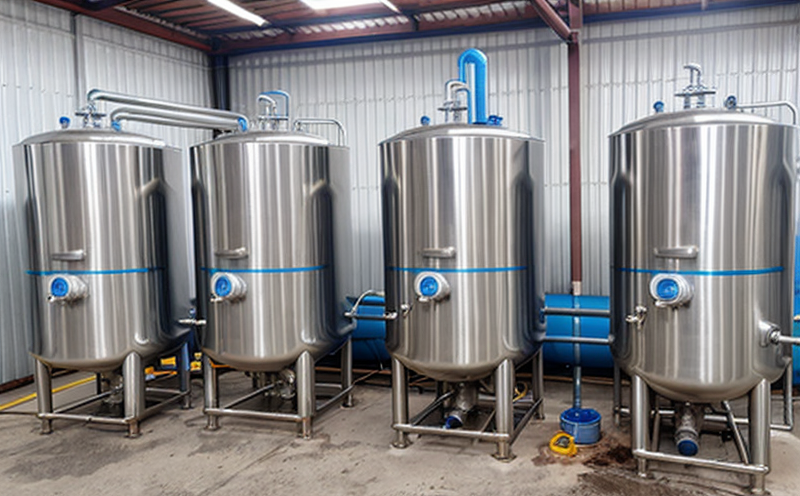ASTM D1125 Conductivity Test in Cooling Water
The ASTM D1125 conductivity test is a critical procedure used to measure the total dissolved solids (TDS) concentration in cooling water systems. This test helps ensure optimal performance and longevity of industrial equipment, particularly boilers and condensers, by identifying potential scaling or corrosion risks.
Conductivity testing serves as a primary diagnostic tool for quality managers and compliance officers responsible for maintaining efficient cooling water cycles. The test evaluates the overall quality of the cooling water to prevent costly downtime due to operational inefficiencies. By monitoring conductivity, R&D engineers can identify trends that might indicate changes in raw water supply or operational parameters.
The ASTM D1125 method involves measuring the conductance between two electrodes immersed in a sample. The electrical resistance is inversely proportional to the concentration of ions present in the cooling water. This relationship allows for accurate quantification of total dissolved salts, which are key indicators of water quality and potential operational issues.
Proper specimen preparation is essential before conducting ASTM D1125 tests. Samples should be taken from a representative location within the cooling water system, ensuring they reflect the overall conditions. Specimens must be kept at room temperature to prevent any changes in ion activity that could affect test results.
The use of appropriate instrumentation is crucial for accurate conductivity measurements. Modern conductivity meters are designed to provide precise and reliable readings, even over extended periods. These devices typically feature interchangeable electrodes and data logging capabilities, allowing technicians to monitor trends over time.
| Applied Standards | Description |
|---|---|
| ASTM D1125-20 Standard Practice for Conductivity Measurements of Water | This standard provides detailed procedures and considerations for conducting conductivity tests on water samples, including preparation, calibration, and interpretation. |
| ISO 8406:2007 Liquid Water - Determination of Total Dissolved Solids (TDS) | An international standard that specifies methods for measuring TDS in liquid water, which is closely related to conductivity tests. |
The ASTM D1125 test plays a pivotal role in maintaining the reliability and efficiency of industrial cooling systems. By detecting early signs of contamination or degradation, this test helps prevent costly repairs and replacements. Regular testing ensures that water treatment processes are optimized, leading to reduced chemical usage and energy consumption.
Customer impact from accurate conductivity testing is significant. Industries relying on efficient cooling systems can expect improved equipment performance, extended lifespan, and reduced maintenance costs. Compliance with industry standards enhances a company's reputation for environmental responsibility and operational excellence.
- Improved Equipment Performance: Early detection of scaling or corrosion prevents damage to critical components such as heat exchangers and condensers.
- Extended Lifespan: By maintaining optimal water quality, the overall lifespan of cooling equipment is extended.
- Reduced Maintenance Costs: Regular testing helps avoid unexpected breakdowns, minimizing downtime and repair expenses.
- Environmental Responsibility: Optimized water treatment processes lead to reduced chemical usage and energy consumption.
In conclusion, the ASTM D1125 conductivity test is an indispensable tool for ensuring the integrity of industrial cooling systems. Its role in maintaining optimal water quality cannot be overstated, as it directly impacts operational efficiency, equipment longevity, and overall environmental sustainability.
Applied Standards
| Standard | Description |
|---|---|
| ASTM D1125-20 Standard Practice for Conductivity Measurements of Water | This standard provides detailed procedures and considerations for conducting conductivity tests on water samples, including preparation, calibration, and interpretation. |
| ISO 8406:2007 Liquid Water - Determination of Total Dissolved Solids (TDS) | An international standard that specifies methods for measuring TDS in liquid water, which is closely related to conductivity tests. |
The ASTM D1125 method is widely recognized and used across various industries due to its reliability and accuracy. Compliance with these standards ensures consistent test results and fosters trust within the industry.
Customer Impact and Satisfaction
- Improved Equipment Performance: Early detection of scaling or corrosion prevents damage to critical components such as heat exchangers and condensers.
- Extended Lifespan: By maintaining optimal water quality, the overall lifespan of cooling equipment is extended.
- Reduced Maintenance Costs: Regular testing helps avoid unexpected breakdowns, minimizing downtime and repair expenses.
- Environmental Responsibility: Optimized water treatment processes lead to reduced chemical usage and energy consumption.
The positive impact of accurate conductivity testing is reflected in customer satisfaction. Companies that implement this test consistently report higher levels of equipment reliability and lower operational costs, leading to enhanced overall performance.
Use Cases and Application Examples
| Use Case | Description |
|---|---|
| Industrial Cooling Systems: | The ASTM D1125 test is used to monitor the quality of water in industrial cooling systems, ensuring optimal performance and longevity. |
| Renewable Energy Plants: | In renewable energy plants, particularly those with large-scale solar or wind farms, conductivity testing helps maintain efficient heat transfer processes. |
These use cases demonstrate the versatility of ASTM D1125 in various industrial settings. The test is crucial for ensuring that cooling water systems operate at peak efficiency, thereby supporting broader sustainability goals within these industries.





